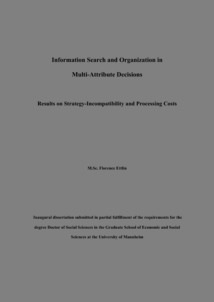|
Information search and organization in multi-attribute decisions : results on strategy-incompatibility and processing costs
Ettlin, Florence
![[img]](https://madoc.bib.uni-mannheim.de/style/images/fileicons/application_pdf.png)  Vorschau |
|
PDF
EttlinFlorence_Dissertation_soSign_MADOC.pdf
- Veröffentlichte Version
Download (27MB)
|
|
URL:
|
https://madoc.bib.uni-mannheim.de/39631
|
|
URN:
|
urn:nbn:de:bsz:180-madoc-396312
|
|
Dokumenttyp:
|
Dissertation
|
|
Erscheinungsjahr:
|
2015
|
|
Ort der Veröffentlichung:
|
Mannheim
|
|
Hochschule:
|
Universität Mannheim
|
|
Gutachter:
|
Bröder, Arndt
|
|
Datum der mündl. Prüfung:
|
8 September 2015
|
|
Sprache der Veröffentlichung:
|
Englisch
|
|
Einrichtung:
|
Fakultät für Sozialwissenschaften > Allgemeine Psychologie (Bröder 2010-)
Außerfakultäre Einrichtungen > GESS - CDSS (SOWI)
|
|
Fachgebiet:
|
150 Psychologie
|
|
Normierte Schlagwörter (SWD):
|
Multiattributive Entscheidung
|
|
Freie Schlagwörter (Englisch):
|
multi-attribute decisions
|
|
Abstract:
|
Abstract
A lot of research on multi-attribute decisions (i.e., choice of the best available option based on information provided by cues) has been devoted to investigate the influence of the way information is presented, and it was concluded that decision makers reduce costs (e.g., effort and time) by adapting information search to the way information is organized. However, two aspects had largely been neglected in this research: (1) Are costs for strategies deviating from the one supported by the information presentation a necessity for effects on decision behavior––or could also purely perceptual presentation manipulations affect decision behavior by providing “visual guidance” for information search? (2) What can be learned about the decision process if the well-structured, often artificial information presentation formats typically used in multi-attribute decisions are abandoned and information organization is left to participants?
Within the scope of this dissertation, the first question was approached with manipulations drawing on Gestalt principles to induce the impression of groups of information. That is, the information was presented in a matrix, and either the rows (representing one information-providing cue each) or the columns (representing one choice option each) were highlighted. Acquiring information column-wise when rows were highlighted or vice-versa was as easy as acquiring the information along the highlighted dimension because the grouping was merely perceptual. No effects on decision behavior emerged with these perceptual manipulations. This result contrasts with previous findings from experiments using much stronger information presentation manipulations (e.g., separate sheets of paper or separate booklets to isolate groups of information). Differential processing costs for the application of different strategies due to the way information is organized are therefore a necessity for information presentation effects to occur; perceptual grouping is not sufficient. Adaptive cost–benefit considerations are thus an adequate explanation for information presentation effects.
The second question was approached with the introduction of a new task format and a corresponding index to assess and quantify subjective information organization. The basic idea was that participants would use subjective information organization to establish a coherent task representation and that subjective information organization would therefore mirror the decision process. In a validation experiment, the task proved sensitive to different decision strategies, and in a simulation study, the index was shown to fulfill basic statistical requirements. In investigations on the importance of a strategy-compatible information organization (i.e., the organization mirrors the strategy’s process), only users of compensatory decision strategies, but not participants using the more frugal non-compensatory Take-the- Best heuristic, organized information in a strategy-compatible manner. Thus subjective information organization did not generally mirror the decision process to support a coherent task representation.
Further investigations showed that the type of display used for the subjective information organization task only increased processing costs for the most information- intensive, strictly compensatory strategies when the organization was strategy-incompatible rather than -compatible. That is, strategies that are considered more cumbersome per se (i.e., more effortful to apply) are more easily affected by a strategy-incompatible information organization. Concerning strategy selection, there was no evidence for an adaptive reduction of the use of strictly compensatory strategies when information was organized in a strategy- incompatible manner. However, whether people really are insensitive to subtle processing costs is subject to future research.
|
 | Dieser Eintrag ist Teil der Universitätsbibliographie. |
 | Das Dokument wird vom Publikationsserver der Universitätsbibliothek Mannheim bereitgestellt. |
 Suche Autoren in Suche Autoren in
Sie haben einen Fehler gefunden? Teilen Sie uns Ihren Korrekturwunsch bitte hier mit: E-Mail
Actions (login required)
 |
Eintrag anzeigen |
|
|
